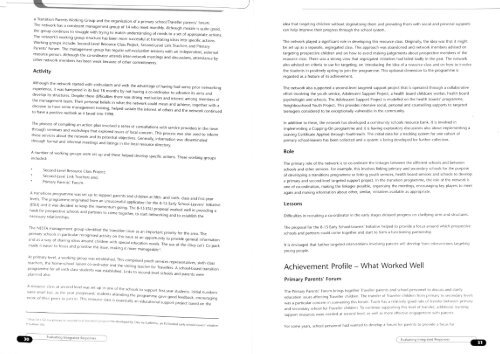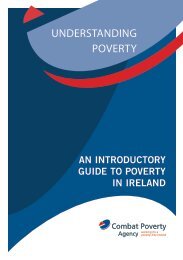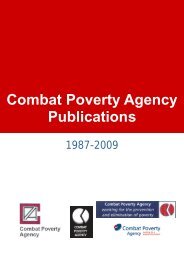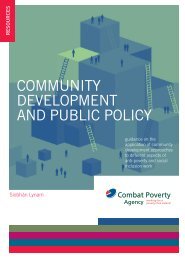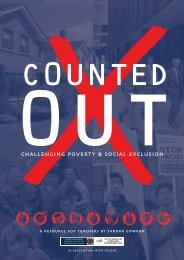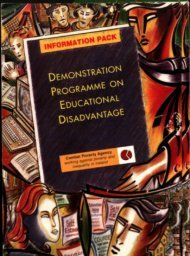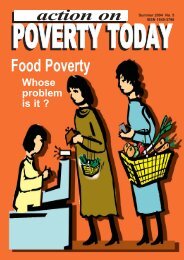Evaluating Integrated Responses to Educational Disadvantage (2000)
Evaluating Integrated Responses to Educational Disadvantage (2000)
Evaluating Integrated Responses to Educational Disadvantage (2000)
- No tags were found...
You also want an ePaper? Increase the reach of your titles
YUMPU automatically turns print PDFs into web optimized ePapers that Google loves.
ActivityA lot of effort was expended in the beginning on establishing a legal entity and clarifying member roles. Thisprocess caused quite a deal of frustration and tension. Network members were discontented by what theysaw as a distraction from the more important work of creating effective linkages between schools andstatu<strong>to</strong>ry and community personnel, and of bringing parents in<strong>to</strong> the network.The co-ordina<strong>to</strong>r developed a comprehensive action plan that outlined the key activities and objectives thatwould be undertaken. However, by mid-1997, he resigned from his position <strong>to</strong> take up a new post. Thiscreated a major void in the network until a successor was appointed the following December.Despite these difficulties, network members started 1998 with a generally positive outlook. A networkstructure and a new co-ordina<strong>to</strong>r were in place and there was a good deal of optimism that the followingperiod would provide an opportunity <strong>to</strong> focus on core issues.As a result of the initial difficulties in sorting out structures and organisational detail, there was a clearconsensus that DYEN in 1998/1999 should focus primarily on practical actions that could demonstrate thevalue of networking. By so doing, it could then encourage the development of appropriate structures.The network is involved also in facilitating discussions on targeting issues and on promoting ways of bringingparents more closely in<strong>to</strong> programme management and development.The network was also involved in providing technical assistance <strong>to</strong> one of the programmes in its applicationfor the 8-15 Early School-Leavers Initiative (ESLI) funding. Although the funding application did not succeed,the proposal did receive support through the ADM/CPA Programme for Peace and Reconciliation. Thenetwork's involvement helped raise its profile and demonstrated that local groups could access resourceswhen they combined their talents and energies in a collaborative process."The network has raised issues and carried through on them. It has supported educa<strong>to</strong>rs in differentcontexts, such as funding applications, developing links with the community and integration. Thenetwork is developing the capacities of the schools and is rated well among the educa<strong>to</strong>rs as a\ result" (Co-ordina<strong>to</strong>r: interview).In addition <strong>to</strong> the above programmes, the network is involved in bringing other existing services <strong>to</strong>gether <strong>to</strong>improve co-ordination of early school-leaver programmes and is also developing a networking forum forlinking the new psychology service for primary schools in the <strong>to</strong>wn <strong>to</strong> existing resource and special needsteachers.Having decided <strong>to</strong> focus on practical network activity, DYEN concentrated on supporting seven separateeducational programmes. These were:* Northside Schools ProjectThis project provides in-school counselling and educational support across three schools on the <strong>to</strong>wn'snorthside. It is funded through the ADM/CPA Programme for Peace and Reconciliation.* Traveller Education and Training CommitteeThis committee brings <strong>to</strong>gether Travellers, resource teachers, workers with Travellers and other workers<strong>to</strong> deal broadly with Traveller issues, in particular education issues. Issues concerning school attendanceand the lack of Traveller children transferring <strong>to</strong> secondary school are discussed in a general way with aview <strong>to</strong> piloting specific programmes for supporting school-retention among Traveller children.Befriender's ProgrammeThis programme is focused on providing counselling and personal support <strong>to</strong> young people. There is aneed for the programme <strong>to</strong> become more linked in with schools for information, advice and referralpurposes. It is operated by the North-Eastern Health Board.* <strong>Educational</strong> SupportThis is an in-schools educational support project that provides intense social and personal support <strong>to</strong>targeted children in a primary school.* Home-School forumTeachers from a single school have developed a forum with parents around a single set of students <strong>to</strong>try <strong>to</strong> enhance their educational potential and opportunities.* Targeted After School ProjectThe project is funded by the ADM/CPA Programme for Peace and Reconciliation and through a localconsortium that is supported by Drogheda Partnership of which the network is a member. The role ofthe network in the consortium is <strong>to</strong> provide a forum for the various consortium groups <strong>to</strong> come<strong>to</strong>gether for mutual learning.* LifestartThis is an early years programme and the network co-ordina<strong>to</strong>r is a member of its management group.The current work programme is quite focused. "Only one or two issues are tackled at a time". A largedatabase has been drawn up of teachers, interested parents and various social service, youth, developmentand voluntary bodies. A regular newsletter has been produced and circulated. This newsletter provides basicinformation on network and other education-related activities.RoleThe overall role of the network in the seven programmes is <strong>to</strong> work closely with personnel and withmanagement committees in developing wider community involvement, and <strong>to</strong> promote effective linkagesbetween and within programmes.LessonsA number of lessons can be drawn from the experience of the network. In its efforts <strong>to</strong> develop a supportstructure in the early days, the network was quite conscious that network members were struggling with theconcept of integration."People are not always reflective and tend <strong>to</strong> be more goal oriented, especially in schools. There maybe an implicit understanding of integration. Such terms are used both as jargon and aspirations forthe purposes of funding.This does not mean people have a real understanding of it" (Co-ordina<strong>to</strong>rinterview).Also of importance was a maturing within the network and a growing recognition that the network needed <strong>to</strong>be focused on making small achievements as a way of building a larger agenda in the long term."Organising practical actions help <strong>to</strong> tie the DYEN <strong>to</strong>gether. There is sharing of information so aseveryone who participates feels they are benefiting. This has been particularly important for schoolsas they have <strong>to</strong> gam clear benefits <strong>to</strong> make it worth their while <strong>to</strong> participate."(Co-ordina<strong>to</strong>r: interview)"Structured networks need one person or organisation with a cl< • ei i way of working <strong>to</strong>drive the network along ... The DYEN has been more informal and looser This ad hoc nature agroups <strong>to</strong> pm as the process continued. It is more bot<strong>to</strong>m up... The structure evolved anas it went along, allowing new groups <strong>to</strong> pm. The institutions already existed They were not put in<strong>to</strong>ma<strong>Evaluating</strong> <strong>Integrated</strong> <strong>Responses</strong>f<strong>Evaluating</strong> <strong>Integrated</strong> <strong>Responses</strong>


